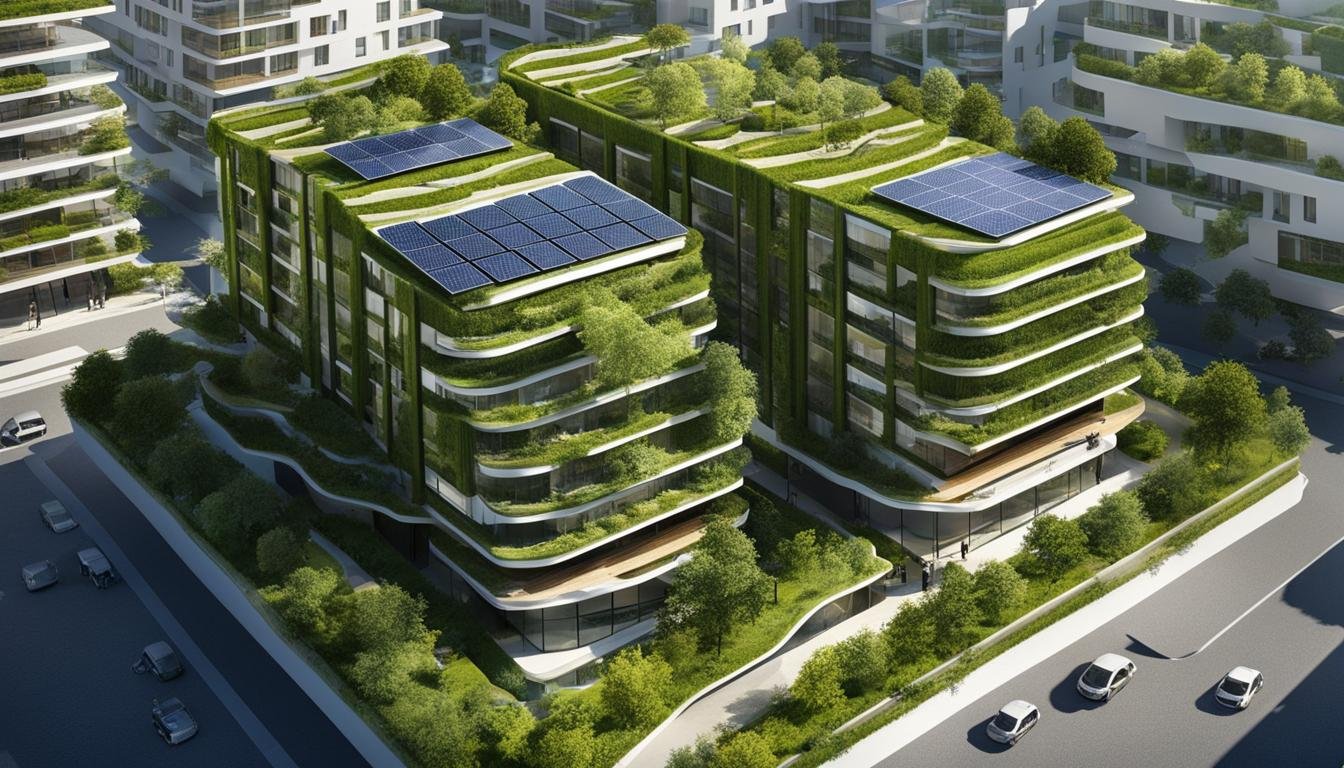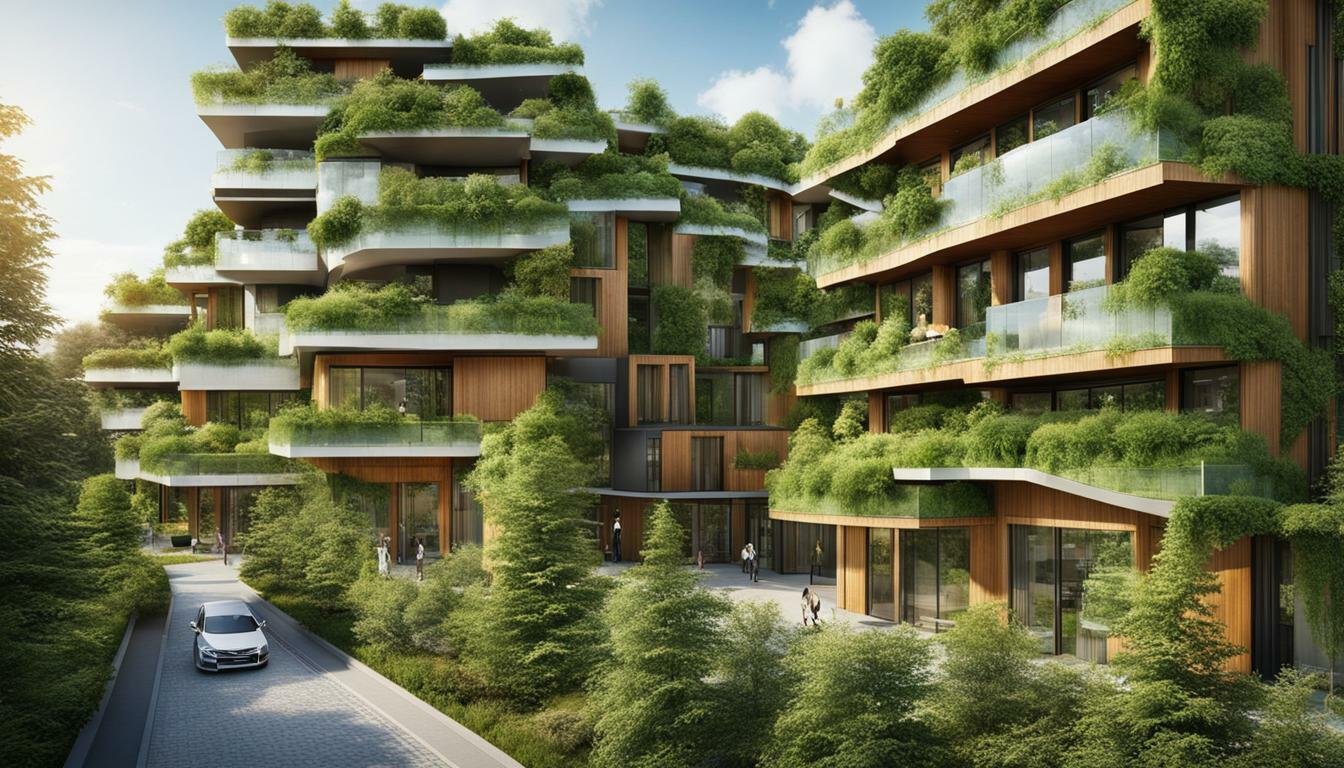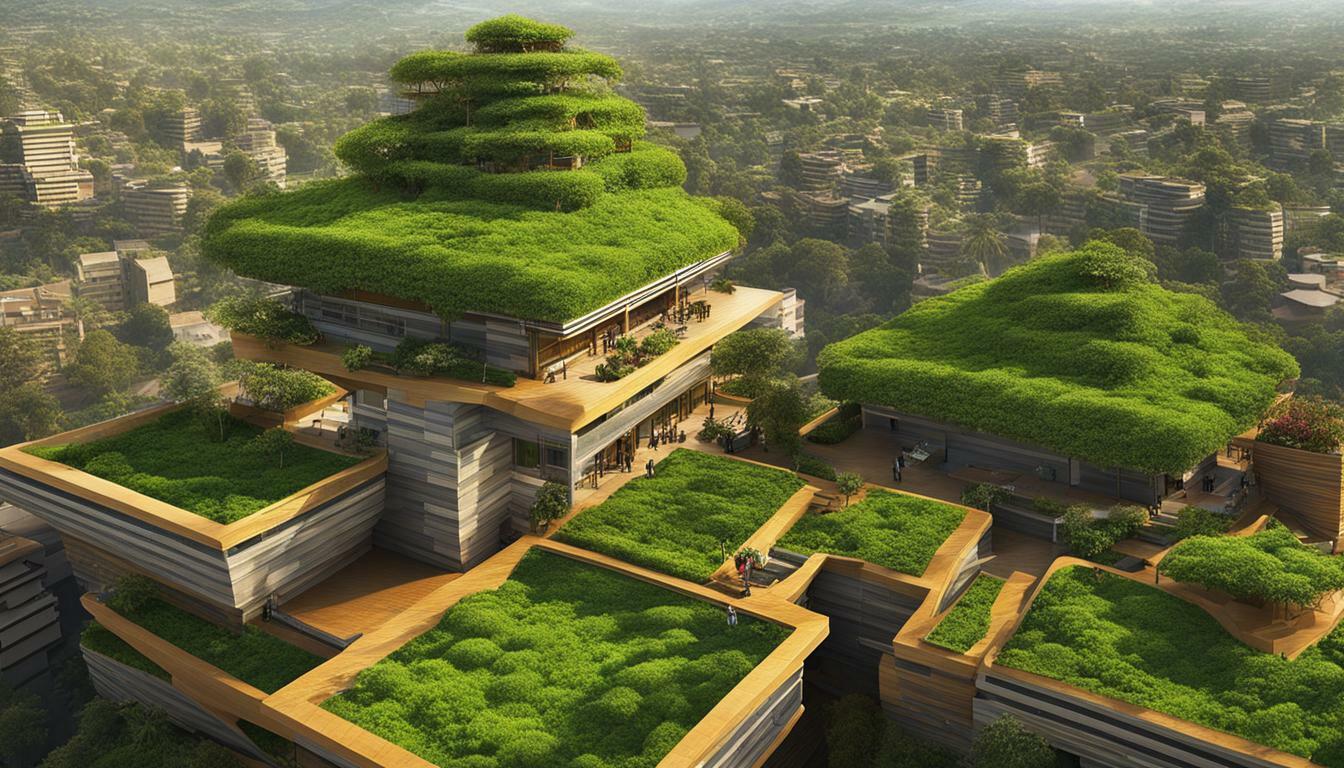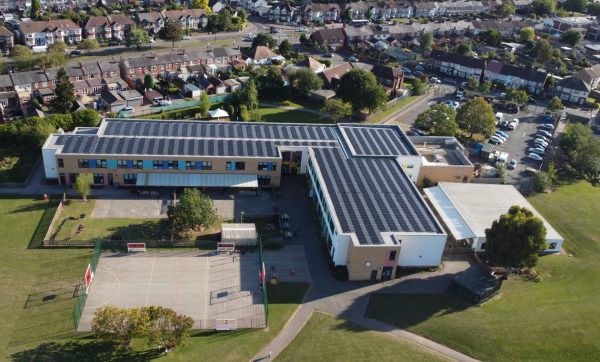Norway’s Top Green Buildings
Discover how Norway is leading the way in sustainable construction with its focus on green buildings. From energy-positive buildings to innovative materials and construction techniques, Norway is at the forefront of shaping a greener future in the construction industry.
Key Takeaways
- Norway is creating energy-positive buildings that produce more power than they consume over their lifetimes.
- Powerhouse and FutureBuilt are initiatives driving sustainable construction in Norway.
- Innovative materials like timber and advanced nanotechnology concrete are being used to reduce carbon emissions.
- Norway is actively transforming construction sites into zero-emission and efficient spaces.
- The City of Oslo is driving decarbonization through public procurement, setting stringent requirements for the industry.
Powerhouse: Redefining Energy-Positive Buildings
Powerhouse, a coalition of architects, engineers, developers, and designers in Norway, is revolutionizing the concept of energy-positive buildings. These buildings go beyond zero-energy by producing more power than they consume over their lifetimes. With a focus on sustainability, Powerhouse projects are at the forefront of innovative design, utilizing sustainable building materials, and maximizing solar energy usage.
One remarkable example of a Powerhouse project is the Drøbak Montessori school. This energy-positive building incorporates solar panels and geothermal energy to minimize its energy consumption. Its unique design maximizes solar energy collection, ensuring that the building generates surplus energy. By utilizing sustainable building materials, such as timber and low-carbon concrete, the Drøbak Montessori school reduces its environmental impact while showcasing the potential for energy-positive buildings.
This energy-positive building incorporates solar panels and geothermal energy to minimize its energy consumption.
Powerhouse’s emphasis on sustainable materials extends beyond individual buildings. The coalition promotes the use of sustainable building materials throughout the construction industry, encouraging developers and designers to consider the environmental impact of their projects. By championing sustainable practices and showcasing the possibilities of energy-positive buildings, Powerhouse is redefining the standards for green construction.
Energy-Positive Buildings in Norway: A Comparative Overview
| Building Name | Location | Energy Generation (kWh/m²/year) | Energy Consumption (kWh/m²/year) |
|---|---|---|---|
| Drøbak Montessori School | Drøbak | 400 | -100 |
| Powerhouse Kjørbo | Sandvika | 525 | -200 |
| Powerhouse Brattørkaia | Trondheim | 485 | -150 |
The table above provides a comparative overview of energy-positive buildings in Norway. These buildings generate more energy than they consume, contributing to the overall energy surplus in the country. The Drøbak Montessori school, for example, generates 400 kWh/m²/year while consuming -100 kWh/m²/year, resulting in a significant surplus that can be fed back into the grid. Powerhouse Kjørbo and Powerhouse Brattørkaia follow a similar energy-positive model, showcasing the capabilities of sustainable design and construction.
Powerhouse’s commitment to energy-positive buildings is driving the transition towards a greener and more sustainable future. By redefining the concept of energy-positive buildings and promoting sustainable materials and designs, Powerhouse is leading the way in the construction industry’s efforts to combat climate change.
FutureBuilt: Pioneering Climate Neutral Urban Areas
Norway’s commitment to sustainable development extends beyond individual buildings to encompass entire urban areas. FutureBuilt, a collaborative initiative between municipalities and partners in the Oslo region, is at the forefront of pioneering climate neutral urban areas. The aim of FutureBuilt is to inspire change in the construction industry by implementing high-quality architecture and sustainable development principles.
Through a series of pilot projects, FutureBuilt showcases the feasibility of climate-friendly urban development and encourages both the public and private sectors to adopt sustainable practices. These projects serve as exemplars of innovative design, energy efficiency, and environmentally conscious construction. By demonstrating the potential for sustainable urban living, FutureBuilt aims to drive the transformation of cities towards a more sustainable future.
“FutureBuilt is leading the way in developing climate neutral urban areas, demonstrating how sustainable architecture and design can be integrated into our cities. By prioritizing energy efficiency and embracing innovative construction techniques, we can create urban spaces that not only have a minimal environmental impact but also offer a high quality of life for residents.” – [Insert Name], Sustainable Architect
The goals of FutureBuilt align with Norway’s broader vision of achieving carbon neutrality and reducing greenhouse gas emissions. By collaborating with municipalities and industry partners, FutureBuilt plays a crucial role in driving sustainable development in the construction sector. Through their efforts, Norway is creating urban areas that are not only environmentally friendly but also prioritize the well-being of its inhabitants.
Table: FutureBuilt Pilot Projects
| Project | Location | Features |
|---|---|---|
| Oslo Airport City Expansion | Oslo | Passive house design, renewable energy sources |
| Fornebu Senter | Bærum | Solar energy, green roofs, sustainable materials |
| Kjørbo | Sandvika | Renovation of existing buildings, energy-efficient measures |

Through FutureBuilt’s pilot projects, such as the Oslo Airport City Expansion, Fornebu Senter, and Kjørbo, Norway is leading the way in sustainable urban development. These projects showcase the innovative integration of renewable energy sources, passive house designs, and energy-efficient measures. By implementing these sustainable solutions, FutureBuilt is making significant strides towards climate neutrality, proving that sustainable development is not only essential but achievable.
Innovative Materials and Construction Techniques
Norway is at the forefront of utilizing innovative materials and construction techniques to reduce carbon emissions in the building industry. The country is exploring carbon capture and storage technology to mitigate CO2 emissions from concrete and steel production. Additionally, Norway is leading in the use of timber as a sustainable alternative to steel in construction. Companies like Moelven have built impressive timber structures, showcasing the strength, flexibility, and durability of timber as a construction material. Furthermore, advancements in nanotechnology have led to the development of concrete that can clean city air by breaking down pollutants.
Carbon Capture and Storage
One of the key innovative solutions being researched and implemented in Norway is carbon capture and storage (CCS) technology. This technology aims to capture carbon dioxide emissions from industrial processes, such as cement and steel production, and store them underground to prevent them from entering the atmosphere. By implementing CCS, Norway is able to significantly reduce the carbon footprint of these industries and make them more sustainable. This not only helps to combat climate change but also paves the way for a more environmentally friendly future in the construction sector.
Timber Construction
Norway is also leading the way in using timber as a sustainable building material. Timber construction offers numerous benefits, including reduced carbon emissions, improved energy efficiency, and a lower environmental impact compared to traditional steel and concrete structures. Companies like Moelven have successfully constructed timber buildings that showcase the versatility and strength of this natural material. These timber structures not only provide aesthetically pleasing designs but also contribute to the overall sustainability of the construction industry.
Concrete with Advanced Nanotechnology
Advancements in nanotechnology have revolutionized the construction industry, particularly in the development of concrete with advanced properties. In Norway, researchers have been working on integrating nanotechnology into concrete to create a more sustainable and environmentally friendly material. This advanced concrete has the ability to break down pollutants in the air, making it a valuable tool in combating urban pollution. By using concrete with advanced nanotechnology, Norway is not only building stronger and more durable structures but also contributing to cleaner and healthier urban environments.
| Benefits of Innovative Materials and Techniques in Green Construction |
|---|
| Reduces carbon emissions |
| Improves energy efficiency |
| Minimizes environmental impact |
| Enhances aesthetics |
| Promotes sustainable practices |

“By embracing innovative materials, construction techniques, and efficient site management, Norway is leading the way towards a greener and more sustainable future in the construction industry.” – Sustainable Construction Magazine
Transforming Construction Sites for Sustainability
Norway is actively working towards transforming construction sites into sustainable spaces. As the largest construction client in the country, the City of Oslo has set strict requirements for contractors to ensure zero-emission construction sites. This commitment to sustainability has led to the development of innovative solutions, such as electric construction equipment, that significantly reduce greenhouse gas emissions.
One of the key initiatives in achieving zero-emission construction sites is the adoption of electric excavators and mixer drums. These electric alternatives replace traditional diesel-powered equipment and help to minimize air pollution at construction sites. By embracing electric construction equipment, Norway is not only reducing carbon emissions but also paving the way for a greener and cleaner construction industry.
Efficient site management is also crucial for sustainable construction practices. Companies like Catenda and RoMY Clima are utilizing technology to improve site management and minimize environmental impact. Catenda offers digital tools that enhance collaboration and communication among project stakeholders, streamlining workflows and reducing waste. RoMY Clima, on the other hand, provides innovative heating solutions without relying on polluting generators, ensuring a more sustainable construction process.
| Benefits of Transforming Construction Sites for Sustainability | Examples |
|---|---|
| 1. Reduced greenhouse gas emissions and air pollution | – Adoption of electric construction equipment – Use of innovative heating solutions |
| 2. Improved site management and communication | – Digital tools for collaboration and workflow optimization |
| 3. Minimized environmental impact | – Reduction of waste through streamlined processes |
In the pursuit of sustainable construction, transforming construction sites into environmentally friendly spaces is paramount. By embracing zero-emission practices and employing electric construction equipment, Norway is leading the way in reducing carbon emissions and air pollution. The integration of innovative technologies for efficient site management further enhances sustainability efforts, promoting collaboration and minimizing waste. These transformative practices mark a significant step towards a more sustainable future in the construction industry.
Zero-Energy and Energy-Positive Buildings
Norway is at the forefront of sustainable architecture, leading the way in the construction of zero-energy and energy-positive buildings. These innovative structures not only prioritize environmental responsibility but also showcase the potential for energy efficiency without compromising aesthetics. The country’s commitment to sustainable building practices has resulted in groundbreaking projects that set new standards for the industry.
One notable example of a zero-energy building in Norway is the new National Museum in Oslo. This architectural masterpiece is designed to be heated by renewable sources, specifically water from the Oslo Fjord. By harnessing natural resources, the museum demonstrates how sustainable design can reduce energy consumption and minimize environmental impact.
The Powerhouse collaboration, which includes renowned architecture firm Snøhetta and other industry leaders, is spearheading the development of energy-positive buildings in Norway. These buildings go beyond being energy-efficient; they generate more energy than they consume over their lifetime. Through innovative design and the integration of renewable energy sources, Powerhouse projects showcase the potential for buildings to actively contribute to the energy grid.

Advantages of Zero-Energy and Energy-Positive Buildings
The adoption of zero-energy and energy-positive buildings offers numerous advantages. Firstly, these structures significantly reduce reliance on traditional energy sources, leading to a substantial decrease in carbon emissions. By generating their own energy, these buildings contribute to the transition towards a more sustainable and climate-friendly future.
Additionally, zero-energy and energy-positive buildings often incorporate the use of sustainable materials and construction techniques. This not only enhances their environmental performance but also promotes the development of a circular economy. By prioritizing the use of renewable resources and minimizing waste, these buildings exemplify the principles of sustainable architecture.
Furthermore, these innovative buildings serve as inspiring examples for the construction industry and the wider public. They demonstrate that sustainable design and energy efficiency are achievable and can coexist with visually striking architecture. By showcasing the potential of zero-energy and energy-positive buildings, Norway is inspiring a global shift towards more sustainable building practices.
The Future of Sustainable Architecture
Norway’s commitment to zero-energy and energy-positive buildings reflects its dedication to sustainable development and environmental preservation. As the country continues to explore new technologies and design strategies, the future of sustainable architecture in Norway looks promising. With ongoing research and innovation, it is anticipated that these buildings will become more widespread, further contributing to a greener and more sustainable built environment.
Public Procurement for Decarbonization
In the pursuit of decarbonization, the City of Oslo is leveraging its purchasing power to drive change and stimulate innovation in the construction industry. Through ambitious public procurement projects, Oslo sets strict requirements for contractors, encouraging the development of low-carbon solutions and fostering collaboration with companies leading the way in sustainability.
By prioritizing carbon-neutral buildings, Oslo is pushing the industry to embrace innovative practices and technologies. This approach not only reduces the environmental impact of construction but also contributes to the city’s goal of becoming carbon neutral by 2030.
One example of Oslo’s commitment to decarbonization is its requirement for fossil-free construction machinery on all city sites. This not only increases demand for electric and sustainable construction equipment but also fosters the development of new technologies that can be adopted industry-wide. Oslo’s forward-thinking approach to public procurement is driving positive change and setting the stage for a greener future.

Sustainable Building in Practice
Sustainable building practices in Norway are not only helping to create a greener future but also offering significant cost reduction benefits. By prioritizing energy efficiency and utilizing eco-friendly materials, buildings can achieve long-term savings on energy consumption and maintenance costs. Norway’s commitment to sustainable construction goes hand in hand with its stringent regulations on timber buildings, making them among the most environmentally friendly structures.

One of the key factors contributing to cost reduction in sustainable buildings is the use of eco-friendly materials that have a lower environmental impact. For example, timber construction is gaining popularity in Norway due to its sustainability and versatility. Timber is a renewable resource that requires less energy to produce compared to traditional building materials. It also has excellent insulation properties, reducing the need for excessive heating or cooling systems.
In addition to sustainable materials, innovative technologies and smart design practices are also contributing to cost reduction in eco-friendly buildings. Companies like Spacemaker AI are utilizing advanced algorithms and machine learning to optimize urban spaces, maximizing both functionality and sustainability. By leveraging technology and fostering collaboration between real estate developers and architects, sustainable urban spaces can be created that benefit both the environment and the community.
| Benefits of Sustainable Building Practices in Norway |
|---|
| Cost reduction through energy efficiency |
| Lower maintenance costs with eco-friendly materials |
| Increased comfort and well-being for occupants |
| Contribution to a greener future and reduced carbon footprint |
| Enhanced durability and resilience of buildings |
By recognizing the long-term value and benefits of sustainable building practices, Norway is paving the way for a more environmentally conscious and economically efficient construction industry. The combination of cost reduction, eco-friendly materials, and sustainable urban spaces creates a win-win situation for both building owners and the planet.
Conclusion
Norway is leading the way in sustainable architecture and green building practices. With initiatives like Powerhouse and FutureBuilt, the country showcases its commitment to creating a greener and more sustainable future. These efforts have put Norway at the top of the list when it comes to eco-friendly buildings and sustainable urban spaces.
Through innovative materials and construction techniques, Norway is revolutionizing the construction industry. From exploring carbon capture and storage technology to utilizing timber as a sustainable alternative to steel, the country is paving the way for a more environmentally friendly approach to building.
In addition, Norway is transforming construction sites into sustainable spaces by implementing zero-emission requirements and developing electric construction equipment. This focus on reducing greenhouse gas emissions and improving site management sets a new standard for the construction industry.
In conclusion, Norway’s dedication to sustainable architecture and green building practices has positioned the country as a global leader in creating eco-friendly buildings. With its innovative mindset and commitment to a greener future, Norway sets an example for other countries to follow in the quest for sustainable development.
FAQ
What is Powerhouse?
Powerhouse is a coalition of architects, engineers, developers, and designers in Norway that aims to construct energy-positive buildings.
What are energy-positive buildings?
Energy-positive buildings produce more power than they consume over their lifetimes, prioritizing energy efficiency and utilizing sustainable building materials.
What is FutureBuilt?
FutureBuilt is a collaboration between municipalities and partners in the Oslo region, working towards the development of climate neutral urban areas through sustainable development principles.
What materials are used in sustainable building practices?
Sustainable building practices in Norway explore innovative materials and construction techniques such as carbon capture and storage, timber construction, and concrete with advanced nanotechnology.
How is Norway transforming construction sites for sustainability?
The City of Oslo, the largest construction client in Norway, has set strict requirements for contractors to ensure zero-emission construction sites. This has led to the development of electric construction equipment and efficient site management practices.
What are zero-energy buildings?
Zero-energy buildings are buildings that consume only as much energy as they produce, often through renewable sources. They are designed with energy efficiency in mind.
How is public procurement driving decarbonization in Norway?
The City of Oslo utilizes its purchasing power to set stringent requirements for the construction industry, stimulating innovation and the development of low-carbon solutions.
What are the cost reduction benefits of sustainable building practices?
Sustainable building practices prioritize energy efficiency and the use of sustainable materials, leading to long-term cost savings for building owners.
What is the significance of Norway in sustainable construction?
Norway is leading the way in sustainable construction with its focus on green buildings, incorporating innovative design, and utilizing sustainable building materials and techniques.








